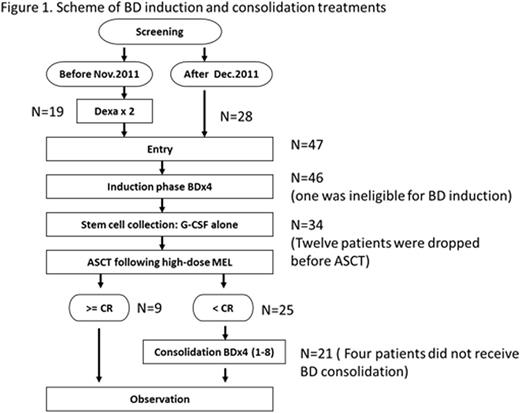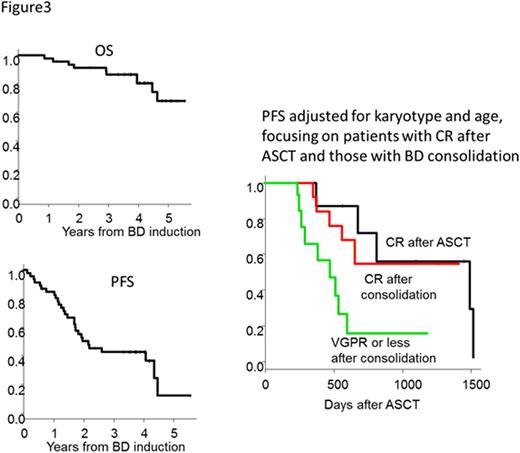Abstract
[Background]
Multiple myeloma (MM) is generally considered incurable. Recently, novel drugs, including bortezomib, have demonstrated a survival benefit for newly diagnosed MM patients compared with classical treatments. Complete response (CR) after treatment is known to be associated with superior progression-free survival. Thus, we prospectively evaluated the efficacy and safety of boretezomib + dexamethasone (BD) for patients with newly diagnosed MM, followed by autologous hematopoietic stem cell transplantation (ASCT). We added BD consolidation therapy to aim CR if CR was not achieved after ASCT.
[Patients and methods]
This clinical study prospectively recruited newly diagnosed MM patients eligible for ASCT between 2010 and 2012. Due to health insurance issues in Japan, two courses of high-dose dexamethasone (HD-DX) had been administrated prior to BD induction treatment until Nov. 2011, while BD was administrated as an initial induction treatment since Dec. 2011. BD induction treatment included 1.3 mg/m2 of bortezomib on days 1, 4, 8, and 11 with 20mg of dexamethasone on days 1, 2, 4, 5, 8, 9, 11, and 12. This BD induction cycle was repeated every 3 weeks for 4 courses. Thereafter, filgrastim-based mobilization and ASCT following high-dose melphalan administration was performed. If patients did not achieve CR after ASCT, BD consolidation therapy (bortezomib: 1.3 mg/m2 on days 1, 8, and 15; dexamethasone 20 mg/day on days 1-2, 8-9, and 15-16) every 4 weeks was added to target CR (Figure 1) (UMIN-CTR: UMIN000002442).
[Results]
The median observational duration among survivors was 1536 days (range: 464-2023) at this analysis. Of the 47 enrolled MM patients, 46 (male 27; female 19) were eligible for BD induction treatment, while the remaining one achieved CR before BD induction. The median age of the patients was 59 (range: 35-67) years. Of the 44 patients whose karyotype analyses were available, normal karyotype was observed in 35. Abnormal karyotype included complex type in 4, diploid in 1, and other abnormalities in 4. FISH revealed deletion of p53 in 5 of 39 patients whose information was available; deletion of 13-chromosome in 16 of 42, IgH-MAF fusion in 1 of 40; IgH-FGFR3 fusion in 5 of 41; IgH-BCL1 fusion in 9 of 39.
Of the 46 MM patients, 19 received HD-DX prior to BD induction, and 34 received ASCT after BD induction treatment (Figure 1). During the BD induction phase, 3 patients experienced disease progression, and BD treatment was discontinued in 9 patients because of their consent withdrawal (n=2) and adverse events (n=7) including interstitial pneumonia in 2, persistent neuropathy in 1, CMV enterocolitis in 1, heart failure in 1, diabetes mellitus in 1, and liver dysfunction in 1.
After BD induction phase (n=46), their response was >= CR in 4 (8%), very good partial response (VGPR) in 10 (22%), partial response (PR) in 18 (39%), stable disease (SD) in 2 (4%), and progression or withdrawal in 12 (26%). After ASCT, their response was >=CR in 9 (20%), VGPR in 11 (24%), PR in 12 (26%), SD in 1 (2%), and additional progression or withdrawal in 1 (2%).
Of the 24 patients who received ASCT and whose response was less than CR, 21 received BD consolidation therapy for a median of 4 courses (range: 1- 8). BD consolidation was discontinued in 4 patients due to persistent neuropathy or cytopenia. Finally, maximum response after ASCT with or without BD consolidation was >= CR in 19 (41%), VGPR in 7 (15%), PR in 6 (13%), < SD in 2 (2%, Figure 2). Through BD consolidation, CR was achieved in 8 of 11 patients with post-ASCT VGPR and 2 of 12 patients with post-ASCT PR.
In total, 4-year progression-free survival (PFS) and overall survival (OS) was 43% (95%CI: 28-57%) and 80 % (95%CI: 64-90%), respectively. Focusing on CR patients after ASCT and those who actually received BD consolidation, PFS adjusted for karyotype and age were not different between CR patients after ASCT and after BD consolidation, while patients with VGPR or less after consolidation had significantly lower PFS (Figure 3).
[Conclusion]
BD induction and ASCT provided CR rate of 27% among ASCT patients, although BD induction may expectedly cause adverse events including persistent neuropathy and viral infections. Patients who achieved CR after ASCT showed good PFS, and targeting CR through BD consolidation might improve CR rate. It is worthwhile to prospectively compare the efficacy of BD consolidation only for patients who failed to achieve CR or universal consolidation strategy.
Kanda:Otsuka Pharmaceutical: Honoraria, Research Funding.
Author notes
Asterisk with author names denotes non-ASH members.




This feature is available to Subscribers Only
Sign In or Create an Account Close Modal